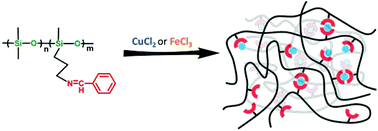Imine-functionalized polysiloxanes for supramolecular elastomers with tunable mechanical properties†
Abstract
Polysiloxanes are a valuable class of hybrid organic/inorganic polymers with excellent properties and broad applications. Thus, developing new synthesis strategies is of great worth to expand the family of functional polysiloxanes and bring in improved properties and unprecedented functions. In this work, we have examined the imine chemistry for post-polymerization functionalization of polysiloxanes and further used these polymers for preparing coordination elastomers. Five kinds of imine-functionalized polysiloxanes were synthesized via the reaction of poly[(aminopropyl)methylsiloxane-co-dimethylsiloxane] with different aromatic aldehydes under mild conditions. All these polymers exhibit excellent thermal stability, a low glass transition temperature, and unconventional photoluminescence behavior. Based on the metal coordination of imine-functionalized polysiloxanes, a series of silicone elastomers were prepared with tunable mechanical properties adjusted by changing the imine content and the metal ion type and content. To the best of our knowledge, this is the first report on the utilization of polymers with simple imines to construct supramolecular coordination elastomers. More importantly, by changing the electronic effect of the imine group to adjust its coordination ability, we provide a new strategy to adjust the mechanical properties of coordination elastomers.



 Please wait while we load your content...
Please wait while we load your content...